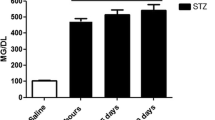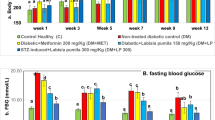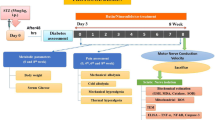Abstract
Diabetic neuropathy (DN) is the highly occurred complication of diabetes mellitus; it has been defined as an event of peripheral nerve dysfunction characterized by pain, allodynia, hyperalgesia, and paraesthesia. The current study was conducted to evaluate the efficacy of low-level laser therapy (LLLT) in the management of neuropathy in diabetic rats. The used animals were divided into the following groups: negative control, streptozotocin-induced diabetic rats, and diabetic rats with peripheral neuropathy (DNP) and DNP treated with gabapentin or with LLLT. Behavioral tests were carried out through hotplate test for the determination of pain sensations and the Morris water maze test for spatial reference memory evaluation. Blood samples were collected at the end of treatment for biochemical determinations. In the current study, the latency of hind-paw lick decreased significantly when DNP are treated with gabapentin or LLLT. The Morris water maze test showed that LLLT treatment improved memory that deteriorated in DNP more than gabapentin do. The results of the biochemical study revealed that LLLT could not affect the level of beta-endorphin that decreased in DNP but significantly decreased S100B that rose in DNP. PGE2 and cytokines IL-1β, IL-10, and TNF-α showed significant increase in DNP compared with control group. The gabapentin administration or LLLT application significantly reversed the levels of the mentioned markers towards the normal values of the controls. Levels of serum MDA and nitric oxide increased significantly in the DNP but rGSH showed significant decrease. These markers were improved significantly when the DNP were treated with gabapentin or LLLT. The treatment with gabapentin or LLLT significantly decreased the raised level in total cholesterol in DNP but could not decrease the elevated level of triglycerides, while LDL cholesterol decreased significantly in DNP treated with gabapentin but not affected by LLLT. Values of serum alanine aminotransferase (ALAT), aspartate aminotransferase (ASAT), urea, and creatinine increased significantly in the DPN and diabetic rats without peripheral neuropathy (PN) compared with control group. The treatment of DNP with gabapentin induced significant increases in ALAT and ASAT activities but LLLT treatment induced significant decreases in ALAT and ASAT activities as compared with DNP group. Neither gabapentin nor LLLT could improve the elevated levels of serum urea and creatinine in the DNP. It could be concluded that LLLT is more safe and effective than gabapentin in the management of neuropathy in diabetic rats.
Similar content being viewed by others
References
Sajak, A., Mediani, A., Maulidiani, Ismail, A., & Abas, F. (2017). Metabolite variation in lean and obese streptozotocin (STZ)-induced diabetic rats via 1H NMR-based metabolomics approach. Applied Biochemistry and Biotechnology, 182(2), 653–668.
Sandireddy, R., Yerra, V. G., Areti, A., Komirishetty P., & Kumar, A. (2014). A neuroinflammation and oxidative stress in diabetic neuropathy: futuristic strategies based on these targets. International Journal of Endocrinology, 2014, Article ID 674987, 10 pages.
Almuhannadi, H., Ponirakis, G., Khan, A., & Malik, R. A. (2018). Diabetic neuropathy and painful diabetic neuropathy: Cinderella complications in South East Asia. The Journal of the Pakistan Medical Association, 68(1), 85–89.
Daino, C.(2017). Is there any difference between diabetic neuropathy and other forms of neuropathy?.mcvitamins.com/health%20articles/diabetes-non-diabetic-neuropathy.htm.
Hosseini, A., & Abdollahi, M. (2013). Diabetic neuropathy and oxidative stress: therapeutic perspectives. Oxidative Medicine and Cellular Longevity, 2013, Article ID 168039, 15 pages.
Pasnoor, M., Dimachkie, M. M., Kluding, P., & Barohn, R. J. (2013). Diabetic neuropathy part 1: overview and symmetric phenotypes. Neurologic Clinics, 31(2), 425–445.
Yagihashi, S., Mizukami, H., & Sugimoto, K. (2011). Mechanism of diabetic neuropathy: where are we now and where to go? Journal of Diabetes Investigation, 2(1), 18–32.
Pirart, J. (1978). Diabetes mellitus and its degenerative complications: a prospective study of 4400 patients observed. Diabetes Care, 1(3), 168–188.
Kasper, D., Fauci, A., Hauser, S., Longo, D., Jameson, J. L., & Loscalzo, J. (2015). Harrison’s principles of internal medicine (19th ed.). United States: McGraw-Hill Education.
Dogan, S. K., Saime, A. Y., & Evcik, D. (2010). The effectiveness of low laser therapy in subacromial impingement syndrome: a randomized placebo controlled double-blind prospective study. Linics, 65(10), 1019–1022.
Lin, D., Huang, M., & Chai, C. (2006). Effects of helium-neon laser on the mucopolysaccharide induction in experimental osteoarthritic cartilage. Osteoarthritis Cartilage, l4(4), 377–383.
Enwemeka, C. S., Parker, J. C., Dowdy, D. S., Harkness, E. E., Sanford, L. E., & Woodruff, L. D. (2004). The efficacy of low-power lasers in tissue repair and pain control: a meta-analysis study. Photomedicine and Laser Surgery, 22(4), 323–329.
Dundar, U., Evcik, D., Samli, F., Pusak, H., & Kavuncu, V. (2007). The effect of gallium arsenide aluminum laser therapy in management of cervical myofacial pain syndrome: a double blind, placebo-controlled study. Clinical Rheumatology, 26, 930–934.
Brosseau, L., Welch, V., Wells, G., Tugwell, P., de Bie, R., Gam, A., Harman, K., Shea, B., & Morin, M. (2000). Low level laser therapy for osteoarthritis and rheumatoid arthritis: a meta-analysis. The Journal of Rheumatology, 8, 1961–1969.
Hsieh, Y. L., Chou, L. W., Chang, P. L., Yang, C. C., Kao, M. J., & Hong, C. Z. (2012). Low-level laser therapy alleviates neuropathic pain and promotes function recovery in rats with chronic constriction injury: possible involvements in hypoxia-inducible factor 1α (HIF-1α). The Journal of Comparative Neurology, 520(13), 2903–2916.
Kim, H. J., Kong, M. K., & Kim, Y. C. (2008). Beneficial effects of Phellodendri Cortex extract on hyperglycemia and diabetic nephropathy in streptozotocin-induced diabetic rats. BMB Reports, 41(10), 710–715.
Hamidi, G. A., Jafari-Sabet, M., Abed, A., Mesdaghinia, A., Mahlooji, M., & Banafshe, H. R. (2014). Gabapentin enhances anti-nociceptive effects of morphine on heat, cold, and mechanical hyperalgesia in a rat model of neuropathic pain. Iranian Journal of Basic Medical Sciences, 17(10), 753–759.
Joensen, J., Gjerdet, N. R., Hummelsund, S., Iversen, V., Lopes-Martins, R. A., & Bjordal, J. M. (2012). An experimental study of low-level laser therapy in rat Achilles tendon injury. Lasers in Medical Science, 27(1), 103–111.
Mikołajczak, P. Ł., Kędzia, B., Ożarowski, M., Kujawski, R., Bogacz, A., Bartkowiak-Wieczorek, J., Białas, W., Gryszczyńska, A., Buchwald, W., Szulc, M., Wasiak, N., Górska-Paukszta, M., Baraniak, J., Czerny, B., & Seremak-Mrozikiewicz, A. (2015). Evaluation of anti-inflammatory and analgesic activities of extracts from herb of Chelidonium majus L. Central European Journal of Immunology, 40(4), 400–410.
Morris, R. G., Garrud, P., Rawlins, J. N., & O'Keefe, J. (1982). Place navigation impaired in rats with hippocampal lesions. Nature, 297(5868), 681–683.
Steel, R. G., & Torrie, G. H. (1980). Principles and procedures of statistics: a biometrical approach (p. 633). New York: McGraw-Hill.
Vinik, A. I., Park, T. S., Stansberry, K., & Pittenger, G. L. (2000). Diabetic neuropathies. Diabetologia, 43(8), 957–973.
Greene, D. A., Stevens, M. J., Obrosova, I., & Feldman, E. L. (1999). Glucose-induced oxidative stress and programmed cell death in diabetic neuropathy. European Journal of Pharmacology, 375(1-3), 217–223.
Oates, P. J. (2008). Aldose reductase, still a compelling target for diabetic neuropathy. Current Drug Targets, 9(1), 14–36.
Sahenk, Z. (2006). Neurotrophins and peripheral neuropathies. Brain Pathology, 16(4), 311–319.
Schmid, U., Stopper, H., Heidland, A., & Schupp, N. (2008). Benfotiamine exhibits direct antioxidative capacity and prevents induction of DNA damage in vitro. Diabetes/Metabolism Research and Reviews, 24(5), 371–377.
Bierhaus, A., Haslbeck, K. M., Humpert, P. M., Liliensiek, B., Dehmer, T., Morcos, M., Sayed, A. A., Andrassy, M., Schiekofer, S., Schneider, J. G., Schulz, J. B., Heuss, D., Neundörfer, B., Dierl, S., Huber, J., Tritschler, H., Schmidt, A. M., Schwaninger, M., Haering, H. U., Schleicher, E., Kasper, M., Stern, D. M., Arnold, B., & Nawroth, P. P. (2004). Loss of pain perception in diabetes is dependent on a receptor of the immunoglobulin superfamily. The Journal of Clinical Investigation, 114(12), 1741–1751.
Boulton, A. J. (1998). Lowering the risk of neuropathy, foot ulcers and amputations. Diabetic Medicine, 15(4), 57–59.
Helewa, A. (1996). Physical therapy management of patients with rheumatoid arthritis and other inflammatory condition. In J. M. Walker & A. Helewa (Eds.), Physical therapy in arthritis (p. 245e65). Philadelphia: W.B. Saunders.
Hecht, J. (1992). Understanding lasers. New York: IEEE Press.
Zhang, Q., Piston, D. W., & Goldmann, R. H. (2002). Regulations of corepressor function by nuclear NADH. Science, 295(5561), 1895–1897.
Karu, T. (1989). Photobiology of low-power laser therapy. New York: Harwood.
Yardan, T., Erenler, A. K., Baydin, A., Aydin, K., & Cokluk, C. (2011). Usefulness of S100B protein in neurological disorders. The Journal of the Pakistan Medical Association, 61(3), 276–281.
Hagiwara, S., Iwasaka, H., Hasegawa, A., & Noguchi, T. (2008). Pre-irradiation of blood by gallium aluminum arsenide (830 nm) low-level laser enhances peripheral endogenous opioid analgesia in rats. Anesthesia and Analgesia, 107(3), 1058–1063.
Biessels, G. J., Deary, I. J., & Ryan, C. M. (2008). Cognition and diabetes a lifespan perspective. Lancet Neurology, 7(2), 184–190.
Kodl, C. T., & Seaquist, E. R. (2008). Cognitive dysfunction and diabetes mellitus. Endocrine Reviews, 29(4), 494–511.
Elias, M. F., Elias, P. K., Sullivan, L. M., Wolf, P. A., & D'Agostino, R. B. (2005). Obesity, diabetes and cognitive deficit: the Framingham heart study. Neurobiology of Aging, 26(1), 11–16.
Honardoost, M., Sarookhani, M. R., Arefian, E., & Soleimani, M. (2014). Insulin resistance associated genes and miRNAs. Applied Biochemistry and Biotechnology, 174(1), 63–80.
Reagan, L. P., Grillo, C. A., & Piroli, G. G. (2008). The As and Ds of stress: metabolic, morphological and behavioral consequences. European Journal of Pharmacology, 585(1), 64–75.
Wessels, A. M., Scheltens, P., Barkhof, F., & Heine, R. J. (2008). Hyperglycaemia as a determinant of cognitive decline in patients with type 1 diabetes. European Journal of Pharmacology, 585(1), 88–96.
Piya, M. K., McTernan, P. G., & Kumar, S. (2013). Adipokine inflammation and insulin resistance: the role of glucose, lipids and endotoxin. The Journal of Endocrinology, 216, 1–15.
Schmidt, A. M., Yan, S. D., Wautier, J. L., & Stern, D. M. (1999). Activation of receptor for advanced glycation end products—a mechanism for chronic vascular dysfunction in diabetic vasculopathy and atherosclerosis. Circulation Research, 84(5), 489–497.
Garcia, F. A., Rebouças, J. F., Balbino, T. Q., da Silva, T. G., de Carvalho-Júnior, C. H., Cerqueira, G. S., Brito, G. A., & Viana, G. S. (2015). Pentoxifylline reduces the inflammatory process in diabetic rats: relationship with decreases of pro-inflammatory cytokines and inducible nitricoxide synthase. Journal of Inflammation, 12, 33.1–3310.
Stemkowski, P. L., Noh, M. C., Chen, Y., & Smith, P. A. (2015). Increased excitability of medium-sized dorsal root ganglion neurons by prolonged interleukin-1β exposure is K+ channel dependent and reversible. The Journal of Physiology, 593(16), 3739–3755.
Magrinelli, F., Briani, C., Romano, M., Ruggero, S., Toffanin, E., Triolo, G., Peter, G. C., Praitano, M., Lauriola, M. F., Zanette, G., & Tamburin, S. (2015).The association between serum cytokines and damage to large and small nerve fibers in diabetic peripheral neuropathy. Journal of Diabetes Research, 2015, Article ID 547834, 7 pages.
Yamaura, M., Yao, M., Yaroslavsky, I., Cohen, R., Smotrich, M., & Kochevar, I. E. (2009). Low level light effects on inflammatory cytokine production by rheumatoid arthritis synoviocytes. Lasers in Surgery and Medicine, 41(4), 282–290.
Mizutani, K., Musya, Y., Wakae, K., Kobayashi, T., Tobe, M., Taira, K., & Harada, T. (2004). A clinical study on serum prostaglandin E2 with low-level laser therapy. Photomedicine and Laser Surgery, 22(6), 537–539.
Bjordal, J. M., Lopes-Martins, R. A., & Iversen, V. V. (2006). A randomised, placebo controlled trial of low level laser therapy for activated Achilles tendinitis with microdialysis measurement of peritendinous prostaglandin E2 concentrations. British Journal of Sports Medicine, 40(1), 76–80.
Mourad, H. H., EL-Kassaby, M. I., El-Hussieny, E. A., Esmail, R. S., Mannaa, F. A., & Abdel-Wahhab, K. G. (2017). Role of soy protein concentrate on oxidative stress and DNA fragmentation in streptozotocin-induced diabetic rats. Journal of Innovations in Pharmaceutical and Biological Sciences, 4, 16–25.
Al-Faris, N. A., Al-sawadi, A. D., & Alokail, M. S. (2010). Effect of samh seeds supplementation (Mesembryanthemum forsskalei Hochst) on liver enzymes and lipid profiles of streptozotocin (STZ)-induced diabetic Wistar rats. Saudi Journal of Biological Sciences, 17(1), 23–28.
Lee, S. H., Park, M. H., Park, S. J., Kim, J., Kim, Y. T., Oh, M. C., Jeong, Y., Kim, M., Han, J. S., & Jeon, Y. J. (2012). Bioactive compounds extracted from Ecklonia cava by using enzymatic hydrolysis protects high glucose-induced damage in INS-1 pancreatic β-cells. Applied Biochemistry and Biotechnology, 167(7), 1973–1985.
Shrivastava, A., Chaturvedi, U., Sonkar, R., Khanna, A. K., Saxena, J. K., & Bhatia, G. (2012). Antioxidant effect of Azadirachta indica on high fat diet induced diabetic Charles Foster rats. Applied Biochemistry and Biotechnology, 167(2), 229–236.
Kou, L., Du, M., Zhang, C., Dai, Z., Li, X., & Zhang, B. (2017). The hypoglycemic, hypolipidemic, and anti-diabetic nephritic activities of zeaxanthin in diet-streptozotocin-induced diabetic Sprague Dawley rats. Applied Biochemistry and Biotechnology, 182(3), 944–955.
Tesfaye, S., Chaturvedi, N., Eaton, S. E., Ward, J. D., Manes, C., Ionescu-Tirgoviste, C., Witte, D. R., & Fuller, J. H. (2005). Vascular risk factors and diabetic neuropathy. The New England Journal of Medicine, 352(4), 341–350.
Kempler, P., Tesfaye, S., Chaturvedi, N., Stevens, L. K., Webb, D. J., Eaton, S., Kerenyi, Z., Tamas, G., Ward, J. D., & Fuller, J. H. (2002). Autonomic neuropathy is associated with increased cardiovascular risk factors: the EURODIAB IDDM complications study. Diabetic Medicine, 19(11), 900–909.
Vincent, A. M., Hayes, J. M., McLean, L. L., Vivekanandan-Giri, A., Pennathu, S., & Feldman, E. L. (2009). Dyslipidemia-induced neuropathy in mice: the role of oxLDL/LOX-1. Diabetes, 58(10), 2376–2385.
Tsuzura, S., Ikeda, Y., Suehiro, T., Ota, K., Osaki, F., Arii, K., Kumon, Y., & Hashimoto, K. (2004). Correlation of plasma oxidized low-density lipoprotein levels to vascular complications and human serum paraoxonase in patients with type 2 diabetes. Metabolism: Clinical and Experimental, 53(3), 297–302.
Recknagel, R. O., GlendeJr, E. A., & Briton, R. S. (1991). Free radical damage and lipid peroxidation. In R. G. Meeks (Ed.), Hepatotoxicology (pp. 401–436). Florida: CRC press.
de Marco, R., Locatelli, F., Zoppini, G., Verlato, G., Bonora, E., & Muggeo, M. (1999). Cause-specific mortality in type 2 diabetes: the Verona diabetes study. Diabetes Care, 22(5), 756–761.
Mullarkey, C. J., Edelstein, D., & Brownlee, L. (1990). Free radical generation by early glycation products: a mechanism for accelerated atherogenesis in diabetes. Biochemical and Biophysical Research Communications, 173(3), 932–939.
Baynes, J. W. (1991). Role of oxidative stress in development of complications in diabetes. Diabetes, 40(4), 405–412.
McLennan, S. V., Heffernan, S., Wright, L., Rae, C., Fisher, E., Yue, D. K., & Turtle, J. R. (1991). Changes in hepatic glutathione metabolism in diabetes. Diabetes, 40(3), 344–348.
Liu, L., Gao, C., Chen, G., Li, X., Li, J., Wan, Q., & Xu, Y. (2013). Notch signaling molecules activate TGF-훽 in rat mesangial cells under high glucose conditions. Journal of Diabetes Research, 2013, Article ID979702, 8 pages.
Meenakshi, P., Bhuvaneshwari, R., Rathi, M. A., Thirumoorthi, L., Guravaiah, D. C., Jiji, M. J., & Gopalakrishnan, V. K. (2010). Antidiabetic activity of ethanolic extract of Zaleya decandra in alloxan-induced diabetic rats. Applied Biochemistry and Biotechnology, 162(4), 1153–1159.
Chen, H. C., Guh, J. Y., Chang, J. M., Hsieh, M. C., Shin, S. J., & Lai, Y. H. (2005). Role of lipid control in diabetic nephropathy. Kidney International. Supplement, 94, S60–S62.
Tuttle, K. R. (2005). Linking metabolism and immunology: diabetic nephropathy is an inflammation disease. Journal of the American Society of Nephrology, l16, 1537–1538.
Lim, A. K., & Tesch, G. H. (2012). Inflammation in diabetic nephropathy. Mediators of Inflammation, 2012, 146154.
Doerner, A. M., & Zuraw, B. L. (2009). TGF-beta1 induced epithelial to mesenchymal transition (EMT) in human bronchial epithelial cells is enhanced by IL-1beta but not abrogated by corticosteroids. Respiratory Research, 10(1), 100–114.
Kamitani, S., Yamauchi, Y., Kawasaki, S., Takami, K., Takizawa, H., Nagase, T., & Kohyama, T. (2011). Simultaneous stimulation with TGF-β1 and TNF-α induces epithelial mesenchymal transitioning bronchial epithelial cells. International Archives of Allergy and Immunology, 155(2), 119–128.
Acknowledgements
The authors would like to thank the authorities of the National Research Centre, Giza, Egypt, for providing the facilities and supporting by the fund (Project Code: 010010318) to carry out this work.
Author information
Authors and Affiliations
Corresponding author
Ethics declarations
Conflict of Interest
The authors declare that they have no conflict of interest.
Rights and permissions
About this article
Cite this article
Abdel-Wahhab, K.G., Daoud, E.M., El Gendy, A. et al. Efficiencies of Low-Level Laser Therapy (LLLT) and Gabapentin in the Management of Peripheral Neuropathy: Diabetic Neuropathy. Appl Biochem Biotechnol 186, 161–173 (2018). https://doi.org/10.1007/s12010-018-2729-z
Received:
Accepted:
Published:
Issue Date:
DOI: https://doi.org/10.1007/s12010-018-2729-z




